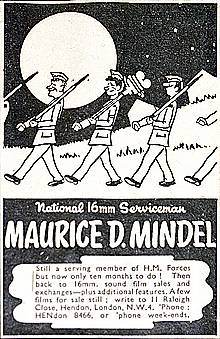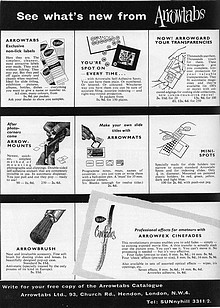| Arrowtabs |
|
|
|||
 |
The advertsiement shown here appears in 'Photography' magazine, December 1966. The right hand side of the advert shows the sort of vertical rotary spindle display that enabled many different 'Arrowtabs' products to be displayed in one place. Arrowtabs existed until 1979 and sold 'carded' photography accessories - "my own range of products with many individual ideas and packaging designs with many thousands of display racks featured in shops throughout the UK".
Some of Maurice's current products can be viewed here. |
||
| Maurice has described his father's, and his own, story, arranged into sequenced phases, which are itemised below. As the story expands, this presentation may become less fragmented, but for now the basic facts are as follows: | |||
|
Maurice Mindel's father, Michael Mindel, was a photographer to royalty and statesmen. Alongside is a company letterhead for the partnership of Mindel & Faraday, Artists and Photographers, from around 1920, with an impressive list of high ranking clientele. Click here, or on the image alongside, to view the letterhead in detail. Also, a photograph of Paul Faraday, believed to be the gentleman business partner whose name appears on the letterhead. |
 |
||
|
Michael Mindel went on to co-found the subsequently world famous Dixons photographic shop chain, with Charles Kalms, in Southend in 1937. Dixons are now DSG International plc and now sells high technology consumer electronics products, audio-video equipment, PCs, small and large domestic appliances, as well as photographic equipment. Maurice believes there is a cine film in his possession, showing this opening. Amateur Photographer magazine (for May 1997 - M.M to confirm exact date) carried an editorial article extolling the 60th Anniversay of this founding, and that article confirms the early involvement of Maurice's father, Michael Mindel. The South East Echo website tells that Michael gave up his share in the business within two years, and Charles Kalms took full control, while continuing to run another business at the same time Click here, or on the image alongside, to read the full article. |
 |
||
|
Maurice Mindel opened his first business after school at age 13 (1946). By 1949 he was selling 16mm sound home movies and was one of the first to sell tape recorders. The news 'cutting' alongside is taken from the "Daily Mirror" newspaper for 27th March 1950. It can be read here, or by clicking on the image alongside. A sales circular for Christmas 1949/50 can be read by clicking here. Maurice was constantly purchasing film stock from a London based wholesale company called 'Peak Films', where a young Michael Ciane (now film star Sir Michael Caine, CBE) worked for a short time around the period that Maurice was purchasing from them. Click here to see a photograph of Michael Caine taken around 1950 at work at Peak Films, possibly packing some Charlie Chaplin 16mm films for Maurice Mindel. |
 |
||
|
National Service During 1952 to 1954, Maurice was in Her Majesty's armed forces, at a time of National Service. In the advertising cartoon
shown alongside, Maurice says: For almost two decades after WW2, the UK required young men to undergo 2 years of National Service. Between 1945 and the end of 1962, 2.5 million young men were compelled to do their time in National Service - with 6,000 being called up every fortnight. The last call-up was in 1960 and the last of those called-up came out of the forces in 1962. By the end of 1962 the aim was for an all-regular force totalling some 375,000 men. |
 |
||
|
Maurice's company called 'Arrowtabs' was founded in 1956 and existed until 1979. The original premises were at Maurice's home address of 11, Raleigh Close, Hendon, London, NW4 and it then moved to Church Road, Hendon, London, NW4 a year or two later. Subsequently Arrowtabs moved to Granville Mews off Cricklewood Lane, London, NW2 and then to Humber Road, Cricklewood, London, NW2 in about 1967/8 (these premises had previously been the Canteen and Sports Centre for Thrupp and Maberly where the bodies of the Humber car were pressed). Arrowtabs sold 'carded' photography
accessories - "my own range of products with many individual
ideas and our own packaging designs with many thousands of display
racks featured in shops throughout the UK". Maurice's first
product was released in 1956 when he was aged 23, being self
adhesive sticky label strips, sized 32mm x 6.5mmin
packs of 130 for 1s.9d (9p). Maurice took out a front cover advertisement
in the leading trade magazine at the time (Photo Trade World)
and sent 6,000 free samples out to all the dealers in the UK.
It became a promising start as 'Arrowtabs' sold £60,000
worth (2014 value) of these stickers in the first year. A series of Arrowtabs product test reports appeared in Modern Camera Magazine (MCM) during 1958 and 1959. These were:
Amateur Photographer magazine, in their 2nd September 1959 issue, also reviewed the 'Strobe-o-Disc'. That test report can be viewed as a pdf by clicking here. Maurice explains "The Strobe-O-Disc was designed by Harold Godfrey, a chemist from Vauxhall (London) who had a penchant for inventing unusual items. I was a sucker for such things – even if they didn’t appear to have much commercial value! The 'Arrow Reel-Ups' was a cine film reel convertor, which 'converted' standard 50feet 8mm cine reels, as returned by cine film processors holding 50feet (4minutes) of amateur cine film, into reels capable of holding 200feet i.e. 4 separate 'films' could be spliced together and stored on a single reel. Maurice says "Reel-Ups must have been my daftest product of all time!" More Arrowtabs products are shown in the advert, right (click here or on the image to enlarge), as advertised in Colour Photography magazine, No.6, 1959 (the last edition for 1959, so likely appeared in November 1959). A further of Maurice's products, being 'Arrow Reel-Ups', was reviewed in Practical Photography magazine, August 1969. That review can be downloaded as a pdf file by clicking here. The Arrowtabs colour transparency (slide) storage systems were reviewed in Amateur Photographer magazine for 18th October 1967. Click here to read the 'What's New?' review. Photography magazine, February 1969, reviewed two further storage systems, one for colour slides and one for negatives. Click here and scroll down. In Amateur Photographer's "News
of the Week" for 21st February 1968, there is an announcement
entitled "Hot Spot - And a £5 Offer". It reads: In 'What's New ?', within the 12th February 1969 edition of Amateur Photographer, there were reviews of the Arrowtabs Accessory Shoe Adaptor (hot flash to coaxial) and Dual Splicer (for Standard 8mm and Super-8mm cine film). Click here to read those reviews. |
 |
||
 |
|||
|
Maurice sold many other photographic products including a complete range of packaged 8mm Home Movies including:
See the cover of 'movie maker' magazine (incorporating Amateur Cine World, 8mm Movie Maker and Cine Camera), for December 1968 (price 3/6d = 17.5p). Click on the cover, or here, to see an enlarged version. Maurice is proud that his was the first photographic company to break the standard 33&1/3rd% discount the trade had accepted for many years and moved to 40%. |
|||
| Below is an Arrow product called the MiniViewer. Its a 35mm (4cmx4cm) colour slide (transparency) viewer of a type where the slide is inserted into the slot between the light brown plastic body and the transluscent plastic end screen and viewed by holding the viewer to the eye and pointing it towards a strong light source. The translucent plastic gave even lighting over the whole slide area and a plastic eye lens gave a magnified image of the slide. | |||
| The viewer is small, the box measures approximately 6cmx6cmx6cm. But despite the 'mini' name (perhaps taking advantage of the 'mini' culture of the UK in the 1960s which included miniskirts and the ubiquitous BMC Mini car) smaller viewers of this type were available. Johnsons made a viewer that worked on the same principles but was of a fold-flat design (as shown in the pictures below). The box measures only 6cmx7cmx1.5cm. | |||
|
|
|
||
|
International Artists (1971-1979) 200 music cassettes and 8 track cartridges for the music industry with all original pack designs and many of Arrowtab's own exclusive recordings. |
|||
|
One favoured recording (nominated
by Matt Taylor) is an Arrowtabs International Artists studio
recording of "Jesus Christ, Superstar" that dates from
1971. Matt owns this on a tape cassette. He says "...it
has much more energy in the performance than any other recording
I’ve heard". Maurice Mindel replied, explaining
the way these tapes had been made. "A music studio or small
record company would decide what was popular in public taste
for music and then bring in talented session musicians and singers
to make a recording. Budget record labels across the world would
then be offered a Master tape for an overall price. They simply
bought the tape, transferred it to cassettes and that was it. In the case of the "Jesus Christ, Superstar" recording, Matt subsequently found this recording to still be available on Amazon, the Alan Caddy Orchestra and Singers. Matt also discovered that Gordon Melville is now living in Hollywood. |
 |
||
| Matt made contact
with Gordon Melville and received the following news: "Jesus Christ Superstar's line up consisted of our usual musicians we used on a regular basis; Clem Catinni on percussion; Bob Falloon, lead guitar; John Fiddy, base guitar; Alan Hawkshore, keyboards. I think we had Freddy Fendor as leader of the brass section and the strings would have been The BBC Light Orchestra. Alan (Caddy) was very pleased with the final result and I'm happy to see it still sells on-line, even today, almost 40 years later. I was not at the session when Alan put the voices on the tracks, but from the sounds I would most certainly say that Danny Street would have been used and for the female parts, Dana Gillespie and Maggie Eaves & her Ladybirds. The other male voice with the gravel tone sounds to me like a singer who did our Rod Stewart recordings i.e. Tony Craige." "I came to America in 1975. Alan went to Canada for a couple of years, but unfortunately he died aged 60 in 2000. I'm still going; I shall be aged 82 next month. If you take a look at www.ave-virtual.com (a website under construction) you will see that Avenue is still alive 'across the pond' (meaning the UK)." |
|||
|
Phase 5 Paul Plus Photo accessories – a range made for Photopia with very advanced packaging and display ideas |
|||
|
Phase 6 Flash Foto (1986) – now trading as Arrowfile – photographic storage systems – selling by catalogue and on the Internet. Maurice has not been actively involved since 2002 due to health reasons. |
|||
|
In 2007, Maurice started the new company "Frame Anywhere" – a new design of photo frame that can be attached to walls and other surfaces, and then readily removed again. |
|||
|
|
|||
|
|
|||
 'Arrowtabs' was founded in 1956 by Maurice Mindel
(his current photograph is shown to the left).
'Arrowtabs' was founded in 1956 by Maurice Mindel
(his current photograph is shown to the left).